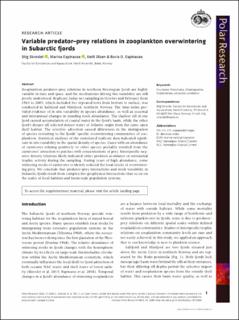| dc.contributor.author | Skreslet, Stig | |
| dc.contributor.author | Espinasse, Marina | |
| dc.contributor.author | Olsen, Ketil | |
| dc.contributor.author | Espinasse, Boris | |
| dc.date.accessioned | 2021-03-12T13:07:40Z | |
| dc.date.available | 2021-03-12T13:07:40Z | |
| dc.date.created | 2020-11-26T12:53:30Z | |
| dc.date.issued | 2020 | |
| dc.identifier.citation | Skreslet, S., Espinasse, M., Olsen, K. & Espinasse, B. D. (2020). Variable predator–prey relations in zooplankton overwintering in subarctic fjords. Polar Research, 39: 3300. doi: | en_US |
| dc.identifier.issn | 1751-8369 | |
| dc.identifier.uri | https://hdl.handle.net/11250/2733183 | |
| dc.description.abstract | Zooplankton predator–prey relations in northern Norwegian fjords are highly variable in time and space, and the mechanisms driving this variability are still poorly understood. Replicate Juday net sampling in October and February from 1983 to 2005, which included five repeated tows from bottom to surface, was conducted in Saltfjord and Mistfjord, northern Norway. The time-series provided evidence of in situ variability in species abundance, as well as seasonal and interannual changes in standing stock abundance. The shallow sill of one fjord caused accumulation of coastal water in the fjord’s basin, while the other fjord’s deeper sill selected denser water of Atlantic origin from the same open shelf habitat. The selective advection caused differences in the immigration of species recruiting to the fjords’ specific overwintering communities of zooplankton. Statistical analyses of the cumulated replicate data indicated significant in situ variability in the spatial density of species. Cases with an abundance of carnivores relating positively to other species probably resulted from the carnivores’ attraction to patches with concentrations of prey. Interspecific negative density relations likely indicated either predator avoidance or substantial trophic activity during the sampling. During years of high abundance, some wintering stocks of carnivores evidently reduced the local stocks of overwintering prey. We conclude that predator–prey interactions and stock variability in Subarctic fjords result from complex bio-geophysical interactions that occur on the scales of local habitats and basin-scale population systems. | en_US |
| dc.language.iso | eng | en_US |
| dc.publisher | Norwegian Polar Institute | |
| dc.rights | Navngivelse-Ikkekommersiell 4.0 Internasjonal | * |
| dc.rights.uri | http://creativecommons.org/licenses/by-nc/4.0/deed.no | * |
| dc.title | Variable predator–prey relations in zooplankton overwintering in subarctic fjords | en_US |
| dc.type | Peer reviewed | en_US |
| dc.type | Journal article | en_US |
| dc.description.version | publishedVersion | en_US |
| dc.rights.holder | © 2020 The Author(s) | en_US |
| dc.subject.nsi | VDP::Matematikk og Naturvitenskap: 400 | en_US |
| dc.subject.nsi | VDP::Matematikk og Naturvitenskap: 400::Zoologiske og botaniske fag: 480::Marinbiologi: 497 | en_US |
| dc.subject.nsi | VDP::Matematikk og Naturvitenskap: 400::Geofag: 450 | en_US |
| dc.subject.nsi | VDP::Matematikk og Naturvitenskap: 400::Zoologiske og botaniske fag: 480::Økologi: 488 | en_US |
| dc.source.pagenumber | 17 | en_US |
| dc.source.volume | 39 | en_US |
| dc.source.journal | Polar Research | en_US |
| dc.identifier.doi | 10.33265/polar.v39.3300 | |
| dc.identifier.cristin | 1852839 | |
| dc.relation.project | Norges forskningsråd: 457.91/008 | en_US |
| dc.source.articlenumber | 3300 | en_US |

